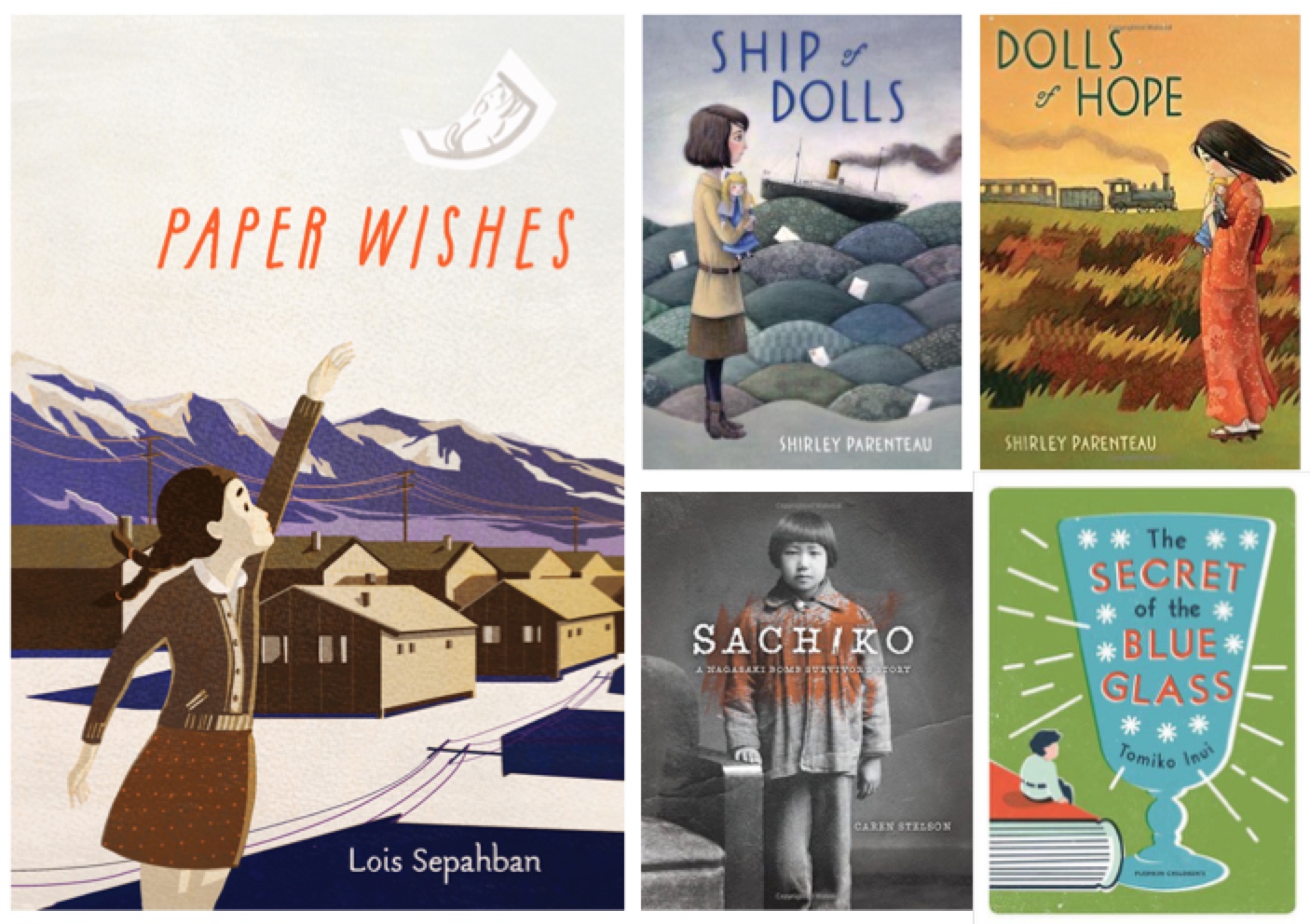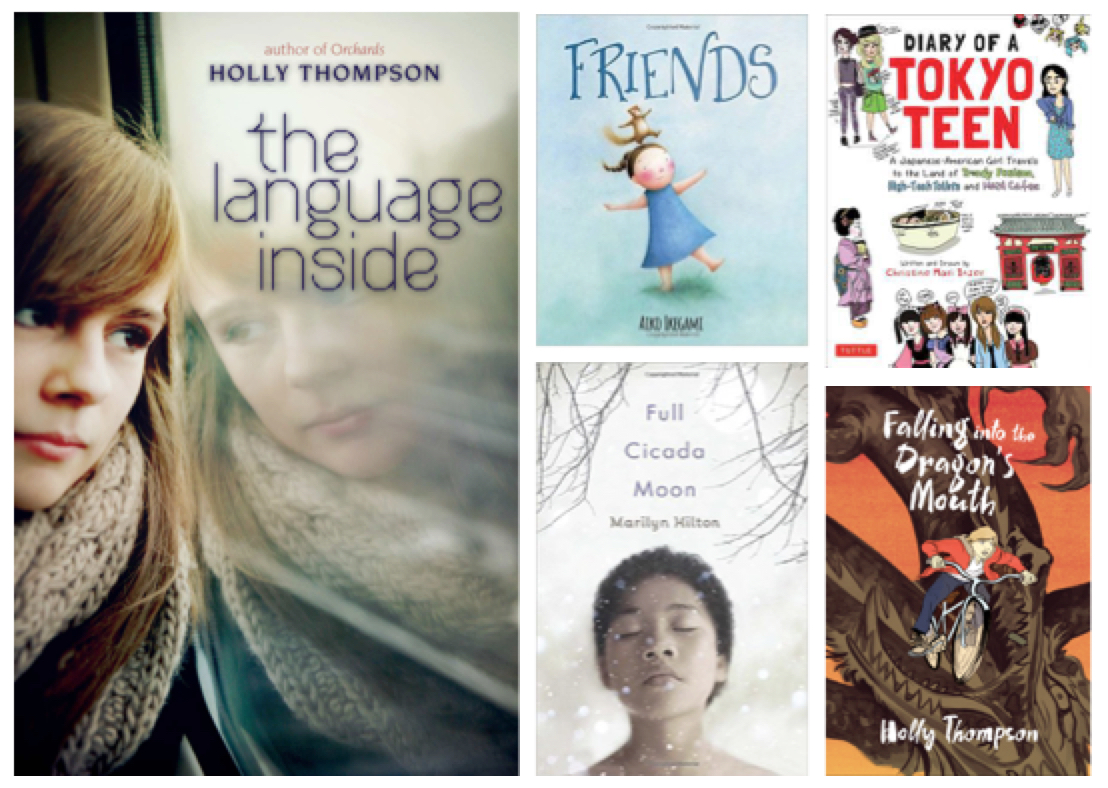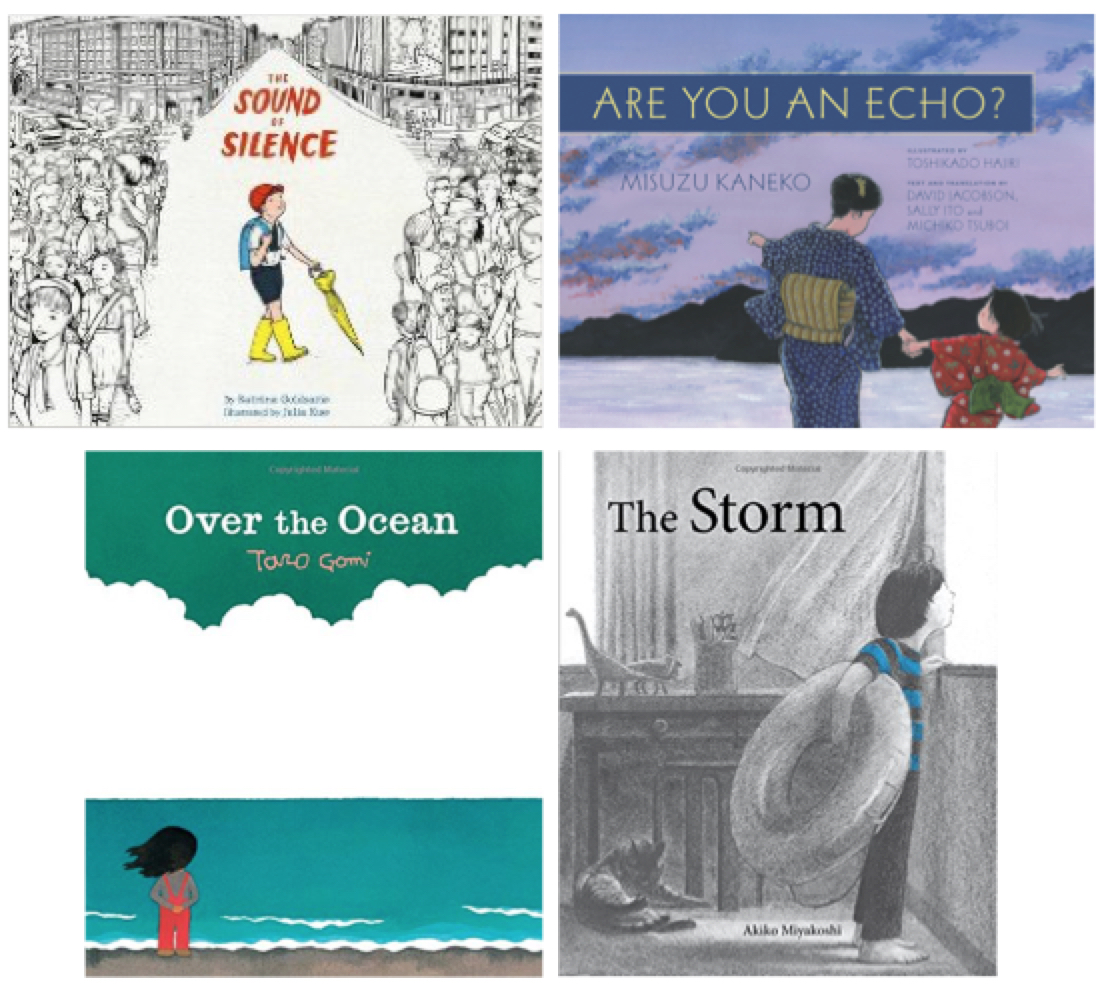By Junko Sakoi, Tucson Unified School District,
and Yoo Kyung Sung, University of New Mexico
This week we discuss newly published children’s literature in the U.S. about Japanese and Japanese-American people in global contexts. Three patterns emerge when we consider the new trends in transnational Japanese children’s books: 1) little-known historical events between Japan and the U.S., 2) transnational children’s and teen’s journeys across time and space, and 3) children’s experiences in universal and cultural contexts.

Little-Known Historical Events between Japan and the U.S.
Japanese internment camps and the Hiroshima bombing are known as major events in Japanese and U.S. history, depicted through both cross-cultural and international picture books and novels, such as So Far from the Sea (1998) by Eve Bunting and Chris K. Soentpiet, Weedflower (2008) by Cynthia Kadohata, and My Hiroshima (1987) by Junko Morimoto. Recently, in addition to those events, authors have begun to tell stories of the little-known histories of the countries.
For instance, the Japan-America Friendship Doll Exchange project in the 1920s is portrayed in two books, Ship of Dolls (2014) and Dolls of Hope (2015). The author, Shirley Parenteau, portrayed this historical event through American and Japanese girls’ perspectives. This particular history regarding the Friendship Doll Exchange may be an unknown piece to Japanese readers as well. The Nagasaki bombing, which is often overlooked because of the Hiroshima bomb’s high degree of exposure in academic discussions and in the media, has also been revealed in children’s books, such as Sachiko: A Nagasaki Bomb Survivor’s Story (2016) written by Caren Stelson.
Title: Ship of Dolls (2014) and Dolls of Hope (2015)
Author: Shirley Parenteau
Genre: Historical fiction novel
These two stories detail the Friendship Dolls Peace Project between Japan and America in the early 20th century. In Ship of Dolls, 11-year-old Lexie and her friends in Portland raise money to ship thousands of dolls to children in Japan and write letters to them. In Dolls of Hope, 11-year-old Chiyo and her friends in Japan help to welcome the dolls from America. Chiyo also helps send Japanese dolls to America in return.
Title: Sachiko: A Nagasaki Bomb Survivor’s Story (2016)
Author: Caren Stelson
Genre: Historical nonfiction narrative
This narrative is about Sachiko Yasui’s survival story of the Nagasaki atomic bomb on August 9, 1945, three days after the Hiroshima bombing. The bomb exploded half a mile from her home when she was six years old. She underwent immediate shock and has suffered from the long-lasting negative emotional, psychological, and physical effects of the bombing.
Title: Paper Wishes (2016)
Author: Lois Sepahban
Genre: Historical fiction novel
A ten-year-old Japanese-American girl, Manami, lives in Bainbridge Island, Washington. Shortly after the Japanese attack on Pearl Harbor, she and her family are forced to leave their home and join the Manzanar camp in California. Because of a severe life in an unfamiliar place without her beloved dog, she loses her ability to speak. Expressing her feelings by writing and drawing helps heal her emotional and psychological pain.
Title: The Secret of the Blue Glass (2015)
Author: Tomiko Inui; Translator: Ginny Tapley Takemori
Genre: Historical fantasy novel
This is Tomiko Inui’s 1959 classic about tiny people from England living in the Miyamoto family’s house in a Tokyo suburb. Yuri fills a blue glass with milk for the little people every morning, which is Miyamoto-family children’s inherited responsibility. But when WWII breaks out, the Miyamoto family’s lives change. Yuri’s father is incarcerated for pacifism; her brothers, ashamed of him, fight for Japan. Eventually Yuri and the tiny people evacuate to a safe place and they struggle with food deficiency.

Transnational Children and Teens’ Journeys across Time and Space
In the late 1800s and early 1900s, a large number of Japanese people immigrated to the U.S. seeking a better life. Their life journeys are portrayed in various historical fiction and nonfiction picture books and novels. Kira Kira (2004) by Cynthia Kadohata, Tea with Milk (1999) by Allen Say, and I am American: A True Story of Japanese Internment (1994) by Jerry Stanley are examples of it. These stories tell Japanese and Japanese-American young people’s struggles with racism and their transnational identities.
Recently, an increase in international marriages between Japanese and Americans, along with a growing number of immigrants from the U.S. to Japan and from Japan to the U.S., has changed the life experiences of people in both countries. The stories share more global and transnational contexts, such as Americans living in Japan, Japan-born Americans in the U.S., Japanese people in the U.S., and America-born Japanese people in Japan. Each of these characters look for and develop their own identity with ties to two or more cultural heritages.
Title: Friends (2016)
Author/Illustrator: Aiko Ikegami
Genre: Modern fantasy picture book
A girl from Japan begins her first day at school. She struggles to fit in because she does not speak the same language as her classmates and looks different than they do. At first, she is alone, but one day, she makes friends with animals and eventually with some of her classmates. Soft, smooth water colors illustrations create a nonthreatening atmosphere, inviting readers to explore the girl’s loneliness and children’s approach to making friends.
Title: The Language Inside (2013)
Author: Holly Thompson
Genre: Contemporary fiction free-verse novel
Emma Karas, a 15-year-old American girl, was born and raised in Japan. When her mother develops cancer, parents choose to move back to the U.S. for medical care. Longing for Japan, Emma tries to look for her place in the U.S., by building relationships with Cambodian refugee friends and expressing her feelings and thoughts by writing poems.
Title: Full Cicada Moon (2015)
Author: Marilyn Hilton
Genre: Historical fiction free-verse novel
In 1969, Mimi Yoshiko Oliver, a biracial 12-year-old girl with an African-American father and a Japanese mother, moves from Berkeley to a predominantly white town in Vermont. She feels out of place, struggling to fit in with her classmates and the rest of the community. Pursuing her dream to become an astronaut empowers her to fight for social justice and find her wings.
Title: Falling into the Dragon’s Mouth (2016)
Author: Holly Thompson
Genre: Contemporary fiction free-verse novel
Jason Parker, a sixth-grade American boy, lives with his family in a seaside town in Japan. His school life is difficult. He is bullied by peers because of his difference as a foreigner. Aikido (a modern Japanese martial art), a weekly international study group meeting, and friendship outside of school give him some relief and courage to persevere through the difficulties.
Title: Diary of a Tokyo Teen: Japanese-American Girl Travels to the Land of Trendy Fashion, High-Tech Toilets and Maid Cafes (2016)
Author/Illustrator: Christine Mari Inzer
Genre: Nonfiction graphic novel
This is the travelogue of a 16-year-old Japanese-American girl living in the U.S., Christine Mari Inzer, regarding Tokyo, Japan, her birthplace. She shares her Tokyo journey from her perspective as a Japanese-American teenager by reconnecting with and rediscovering her Japanese heritage.

Children’s Experiences in Universal and Cultural Contexts
Many fiction and nonfiction picture books have been translated from Japanese into English and are available in the U.S. The books present Japanese culture and traditions, folklores, famous people, history, and animals. In addition, universal themes on children’s culture and experiences are portrayed in several books, such as sisterhood in Yoriko Tsutsui and Akiko Hayashi’s Naomi’s Special Gift (2006) and a grandson-grandfather relationship in Takaaki Nomura’s Grandpa’s Town (1991).
These stories include cultural moral lessons, as well: how to be nice to friends, how to look after younger siblings, or how to talk with elderly people. Recent stories demonstrate some changes in these universal themes. Children’s curiosity and inquiries about the world — which are intricately intertwined with various feelings and emotions such as excitement, happiness, or worry — have been sensitively depicted both in contemporary and historical contexts of Japan. These books will bridge insights for American readers into Japanese culture as they make personal connections.
Title: Over the Ocean (2016)
Author/Illustrator: Taro Gomi
Genre: Contemporary realistic fiction
A little girl looks over the ocean, imagining the other side of the unknown world. She wonders “What is beyond the ocean? Are there more oceans?… Maybe there are cities over the ocean. Full of tall buildings…or small houses. Maybe there are kids living there. Are they all friends?” She wonders about places and children who are similar to herself. Originally published in Japan in 1979, this is a timeless picture book that still speaks to children today.
Title: The Storm (2016)
Author/Illustrator: Akiko Miyakoshi; Editors: Yvette Ghione and Katie Scott
Genre: Contemporary realistic fiction
It’s Friday. A little boy is very excited about a trip to the beach with his parents tomorrow. But a bad storm is coming. The sky is growing darker, the wind is blowing harder, the rain is getting heavier, and the boy worries about the trip. White and black charcoal illustrations echo his tension and anxiety. That night, he dreams that he can blow away the dark clouds with his imaginary vessel. He wakes up in the morning and finds that his dream comes true. There is clear blue sky.
Title: The Sound of Silence (2016)
Author: Katrina Goldsaito; Illustrator: Julia Kuo
Genre: Contemporary realistic fiction
On a rainy day in modern-day Tokyo, a large and busy city, a little boy hears a symphony of sounds: boots splashing puddles, raindrops pattering on his umbrella, cars beeping, and families laughing. Then he hears the sound of a koto (Japanese traditional stringed musical instrument) that a woman is playing. “Do you have a favorite sound?” the boy asks, and she answers “Ma,” which means “the silence between sounds.” “Where is silence?” He starts looking for it.
Title: Are You an Echo? (2016)
Author: Misuzu Kaneko; Illustrator: Toshikado Hariri;
Translators: Sally Ito, David Jacobson, Michiko Tsuboi, and Setsuo Yazaki
Genre: Biography and poetry
This is the inspiring life story of Misuzu Kaneko, a Japanese poet of the early 20th century, along with a collection of her poetry in both English and Japanese. As an inquisitive lover of literature, Misuzu started to write poems at a young age. She always inquired about the world around her and expressed them in her poetry. For example, in one of her poems, she wrote, “I wonder why the rain that falls from black clouds, shines like silver. I wonder why the silkworm that eats green mulberry leaves is so white.”
Journey through Worlds of Words during our open reading hours: Monday through Friday 9 a.m. to 5 p.m., Saturday 9 a.m. to 1 p.m. Check out our two online journals, WOW Review and WOW Stories, and keep up with WOW’s news and events.
- Themes: Japanese Children's Literature, Junko Sakoi, Yoo Kyung Sung
- Descriptors: Books & Resources, Debates & Trends, WOW Currents

Priceless article! Thank you.